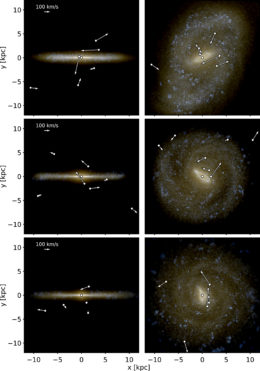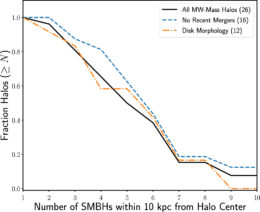Are supermassive black holes found only at the centers of galaxies? Definitely not, according to a new study — in fact, galaxies like the Milky Way may harbor several such monsters wandering through their midst.
Collecting Black Holes Through Mergers
It’s generally believed that galaxies are built up hierarchically, growing in size through repeated mergers over time. Each galaxy in a major merger likely hosts a supermassive black hole — a black hole of millions to billions of times the mass of the Sun — at its center. When a pair of galaxies merges, their supermassive black holes will often sink to the center of the merger via a process known as dynamical friction. There the supermassive black holes themselves will eventually merge in a burst of gravitational waves.

Spatial distribution and velocities of wandering supermassive black holes in three of the authors’ simulated galaxies, shown in edge-on (left) and face-on (right) views of the galaxy disks. Click for a closer look. [Tremmel et al. 2018]
Black Holes in an Evolving Universe
Led by Michael Tremmel (Yale Center for Astronomy & Astrophysics), a team of scientists has used data from a large-scale cosmological simulation, Romulus25, to explore the possibility of wandering supermassive black holes. The Romulus simulations are uniquely suited to track the formation and subsequent orbital motion of supermassive black holes as galactic halos are built up through mergers over the history of the universe.
From these simulations, Tremmel and collaborators find an end total of 316 supermassive black holes residing within the bounds of 26 Milky-Way-mass halos. Of these, roughly a third are wanderers within 10 kpc of the halo center (roughly the size of the Milky Way’s disk).
These wandering supermassive black holes were kicked onto wide orbits during the merger of their host galaxy with the main halo; Tremmel and collaborators find that their orbits are often tilted, lying outside of the galactic disk. Because these black holes travel through relatively deserted regions, they accumulate little mass and are rarely perturbed in their journeys, wandering for billions of years.
Finding Monsters

Cumulative fraction of simulated Milky-Way-mass halos as a function of the number of supermassive black holes they host. All of the halos host at least one SMBH within 10 kpc from halo center, but the majority host more than that. [Tremmel et al. 2018]
So how can we find these invisible monsters? We already have some observational evidence — in the form of offset and dual active galactic nuclei — of non-central supermassive black holes in distant galaxies. As for nearby, our best bet is to look for tidal disruption events, the burps of emission that occur when an otherwise invisible black hole encounters a star or a cloud of gas.
Citation
Michael Tremmel et al 2018 ApJL 857 L22. doi:10.3847/2041-8213/aabc0a

1 Comment
Pingback: MW's SMBH may have unseen siblings